Physical Address
304 North Cardinal St.
Dorchester Center, MA 02124
The major role of respiratory cytology is in diagnosis of malignant neoplasms involving the lung, both primary and metastatic. Cytologic techniques are also useful for staging primary lung carcinomas. Opportunistic infections, specific inflammatory processes, and some benign neoplasms may also be diagnosed cytologically. Before interpreting a cytologic sample from the respiratory tract, it is important to know how the specimen was collected. Sampling techniques greatly influence the cytologic appearance of the specimen ( Fig. 36.1 ). Respiratory cytology samples may be obtained using exfoliative methods or by fine-needle aspiration (FNA).
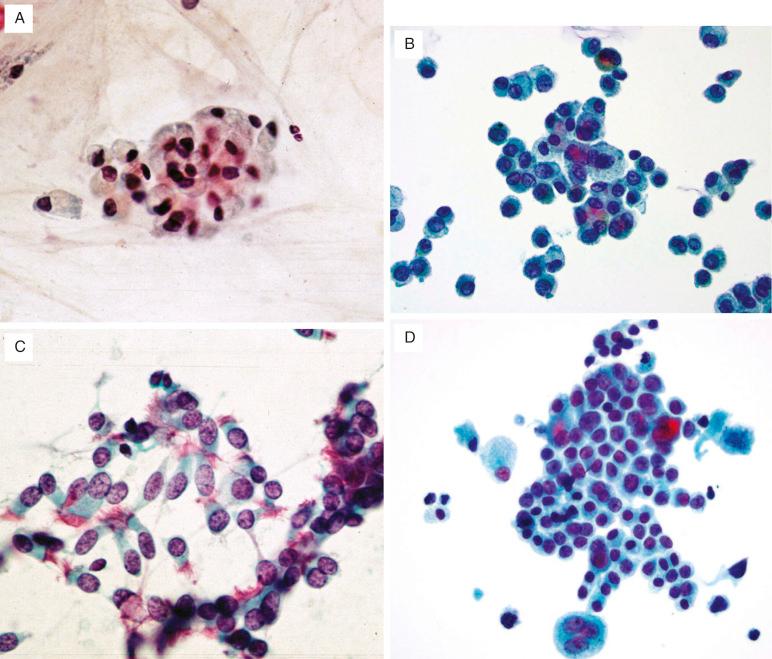
Exfoliative respiratory cytology techniques include sputum cytology, bronchial cytology (washings and brushings), and bronchoalveolar lavage (BAL). Various factors influence the diagnostic yield of exfoliative techniques, including tumor location, size of the lesion, and tumor cell type. Overall, exfoliative methods have a reported sensitivity and specificity of 70% to 80%. False-positive diagnoses are rare, and patients can be treated on the basis of the cytologic diagnosis alone.
Sputum samples are most commonly obtained from symptomatic patients. Cytologic examination of sputum has a number of advantages. Samples are easily obtained in a noninvasive manner, and the samples reflect constituents from many regions of the lung. Sputum cytology is most useful in diagnosing centrally located malignancies (small cell carcinoma and squamous carcinoma). A spontaneously produced morning sputum sample has the highest diagnostic yield, and examination of three to five samples is desirable to further increase this diagnostic yield. Techniques for inducing sputum samples in asymptomatic patients using a nebulizing solution have been reported. Induced sputum samples can also be used for assessing inflammation in patients with chronic respiratory conditions such as asthma, sarcoidosis, and chronic obstructive pulmonary disease and for diagnosing respiratory infections.
Sputum samples may be prepared by a variety of methods. The “pick and smear” method involves visual inspection of fresh specimens with selective smearing of strands or flecks of solid material. Sputum samples may also be prepared using the Saccomanno method in which sputum samples collected in 50% ethanol and 2% polyethylene glycol (Carbowax) are placed in a blender, homogenized, and concentrated before smearing. Most commonly today, alcohol or another proprietary fixative is added to a fresh sputum sample, and the specimen is processed using cytospin or monolayer techniques. Numerous alveolar macrophages are required for a sputum sample to be considered adequate for evaluation, though there is no numeric standard. Ciliated bronchial epithelial cells are insufficient evidence of adequacy.
There are a number of disadvantages of sputum cytology. Sputum samples can be difficult to obtain or unsatisfactory if lower respiratory tract elements are not represented. Sputum evaluation does not help to localize a lung lesion. Sputum evaluation is less accurate for diagnosis of adenocarcinoma, metastases, and lymphoma compared with tumors of other cell types. Most peripherally located tumors and most benign tumors cannot be diagnosed in sputum.
In many institutions, sputum cytology has been largely replaced by bronchial cytology. Indications for fiber-optic bronchoscopy include persistent cough, new solitary pulmonary nodule, persistent chest radiographic infiltrate, hemoptysis, bronchial obstruction, atelectasis, persistent localized wheezing, and confirmation of abnormal sputum cytology. Bronchial cytologic specimens are collected during bronchoscopy and include bronchial washings and brushings. To obtain a bronchial washing sample, the bronchoscope is positioned in the area of the abnormality, and repetitive installation and reaspiration of 3 to 5 mL of a balanced saline solution are performed. The reaspirated material can be sent fresh to the laboratory or placed in an appropriate cytologic fixative. Bronchial brushings are then obtained using a small, circular, stiff-bristle brush with preparation of direct smears followed by rinsing of the brush in a preservative solution. Bronchial cytologic samples must be obtained before tissue biopsy procedures are performed to minimize peripheral blood contamination.
Advantages of bronchial cytology include the ability to localize and directly visualize a lung lesion and acquire a sample directly from this area. Bronchial techniques are better than sputum cytology for peripheral tumors and small tumors. Adequate bronchial specimens show large numbers of ciliated bronchial epithelial cells and alveolar macrophages. Bronchial specimens should be considered unsatisfactory for evaluation if there is heavy oral contamination or obscuring blood, inflammation, or drying artifact. Disadvantages include the need to undergo the procedure, which can be unpleasant for the patient. Also, these techniques sample a limited area of the lung. Furthermore, benign tumors and tumors in the extreme periphery of the lung are difficult to diagnose using bronchial cytology.
BAL is a method used to evaluate the most distal airspaces. As such, it is a technique used to investigate diffuse disease processes. It is most commonly used in immunocompromised patients with pulmonary infiltrates due to suspected opportunistic infections. Cultures and special stains for microorganisms can be performed on the cytology sample. BAL is also useful in the setting of interstitial lung disease, pulmonary hemorrhage, lymphoproliferative disorders, and malignancy. To obtain a BAL sample, the bronchoscope is wedged into a subsegmental bronchus and a large volume (100–300 mL) of warm saline is instilled and reaspirated in 20- to 100-mL aliquots. The first aliquot is discarded, and the remaining aliquots are pooled. The resulting sample is sent fresh to the laboratory. Adequate BAL specimens have abundant alveolar macrophages. Excessive numbers (>75%) of ciliated respiratory epithelial cells or squamous cells indicate contamination and are not satisfactory. Specific rejection criteria exist but are not widely used.
FNA cytology of the respiratory tract can be performed through the bronchoscope or via a transthoracic approach. Percutaneous transthoracic FNA is most often used for peripheral lung lesions suspected to represent malignancies. This technique is superior to sputum and bronchial cytology for tumors that are not associated with airways. Percutaneous transthoracic FNA requires a sterile field and anesthesia. Radiographic guidance (computed tomography [CT], fluoroscopy) is needed to confirm needle position. The aspirate is performed, and direct smears with or without a needle rinse are prepared. Immediate assessment of specimen adequacy is optimal to minimize the number of needle passes. Repeat aspirations may be performed as needed. A major diagnostic pitfall using this technique is the misinterpretation of normal and reactive mesothelial cells as malignancy.
Transbronchial FNA is performed through the bronchoscope. Advances in image guidance for transbronchial FNA have dramatically increased its use in both diagnosis and staging of patients. Examples of image guidance include endobronchial ultrasound-guided (EBUS) FNA, as well as electromagnetic navigation–guided techniques. These modalities use real-time image guidance during the bronchoscopy procedure and have advanced the ability to sample previously inaccessible lung nodules and lymph nodes. Image-guided transbronchial FNA is more sensitive than traditional FNA, with sensitivities in the literature from 90% to 95% and specificity approaching 100%. These techniques may be performed with patients under either conscious sedation or general anesthesia. There are few contraindications to these procedures, and they are useful in patients who are not surgical candidates. There is an overall low risk of complications. Rapid on-site evaluation (ROSE) has been shown to increase the value of EBUS FNA for patients (EBUS FNA alone 92% sensitive; EBUS with ROSE 97% sensitive).
Overall, the sensitivity of lung FNA is 75% to 95%, and specificity is 95% to 100%. An exact classification of a malignant tumor is achieved in 70% to 85%. Diagnostic accuracy in separating small cell carcinoma from non–small cell carcinoma is reportedly 90% to 100%. FNA techniques are associated with more complications than sputum and bronchial cytology, particularly pneumothorax and hemoptysis. Only 5% to 10% of patients who develop a pneumothorax require treatment, however. Air embolism is a rare but fatal complication of FNA. The complication rate is related to the depth and size of the lesion, number of FNA passes, and operator experience. Also, needle size is important, with higher needle gauges associated with fewer complications.
Curschmann spirals
Charcot-Leyden crystals
Amyloid
Ferruginous bodies
Psammoma bodies
Corpora amylacea
Contaminants (pollen, food, etc.)
The respiratory system is divided into the upper and lower respiratory tracts. Nonkeratinizing stratified squamous epithelium lines the upper portion of the respiratory tract, and respiratory epithelium lines the lower portion. Types of epithelial cells commonly encountered in respiratory tract samples include squamous cells, ciliated columnar bronchial epithelial cells, goblet cells, and alveolar pneumocytes ( Fig. 36.2 ). In the normal state, these cells are easily identified. It is important to become familiar with benign reactive changes in these normal cell types to avoid misinterpreting benign changes as malignancy ( Fig. 36.3 ). Reactive cells show enlarged nuclei with a mild-to-moderate degree of nuclear pleomorphism. Nucleoli are prominent. Overall, however, cohesion is maintained and cells are arranged in flat sheets. There is a range of cellular atypia, and there is not an identifiable discrete population of abnormal cells. The nuclear-to-cytoplasmic ratio is maintained. Importantly, any cells with cilia in respiratory cytology are benign cells. Reactive ciliated bronchial epithelial cells are commonly multinucleated.
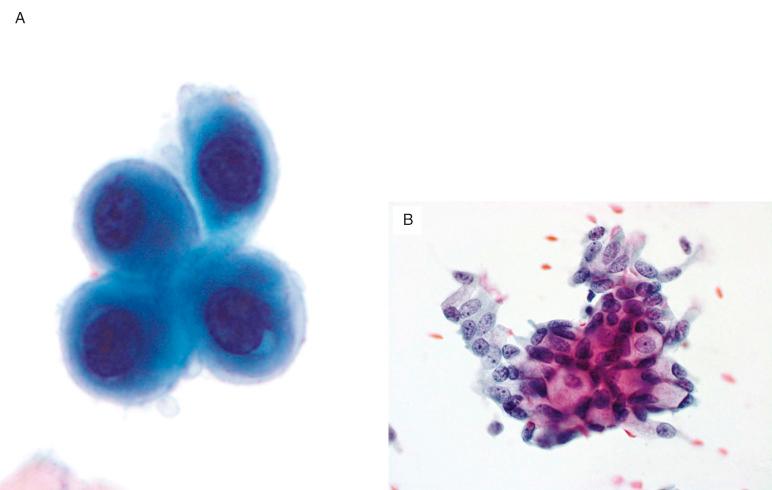
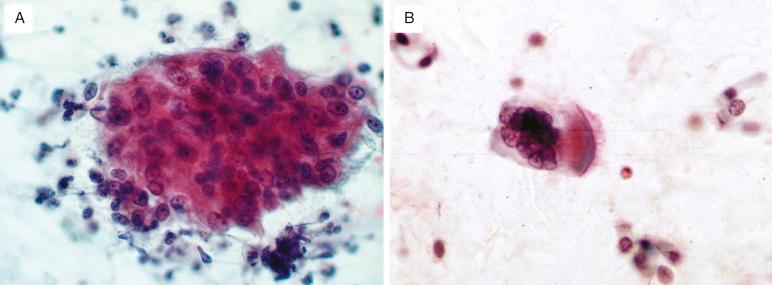
It is also important to recognize benign cellular proliferations in respiratory cytology, including bronchial hyperplasia (Creola bodies), goblet cell hyperplasia, reserve cell hyperplasia, and squamous metaplasia ( Fig. 36.4 ). These changes occur in response to epithelial injury and, if unrecognized, may be mistaken for malignancy. Epithelial injury by inflammation with airway remodeling occurs commonly in patients with asthma. Epithelial cell shedding may be pronounced in these patients, and it is estimated that asthmatic patients have a fourfold greater number of epithelial cells in BAL specimens than their normal counterparts. Ciliated columnar epithelial cells are preferentially denuded, and clusters of these sloughed epithelial cells are referred to as bronchial hyperplasia or Creola bodies. These cell clusters may have a rounded appearance, mimicking clusters of adenocarcinoma cells. However, cells of bronchial hyperplasia have cilia, and the nuclei in the cluster are normal and identical to the adjacent single bronchial epithelial cell nuclei. The presence of eosinophils and Charcot-Leyden crystals can also suggest a diagnosis of asthma. Numerous goblet cells may be seen in patients with chronic lung diseases, particularly chronic obstructive pulmonary disease and asthma. Goblet cell hyperplasia can also be mistaken for adenocarcinoma, particularly the lepidic pattern of adenocarcinoma (formerly bronchoalveolar carcinoma), unless attention is paid to the bland nuclear features of the former. In response to an injury resulting in epithelial sloughing, reserve cell hyperplasia can be seen. It is the function of these reserve cells to regenerate the respiratory epithelium. Cells of reserve cell hyperplasia can mimic small cell carcinoma, and nuclear molding may be seen. However, reserve cells have small, condensed, uniform nuclei, and the necrotic background and lack of cellular cohesion typical of small cell carcinoma are absent. Squamous metaplasia, also a response to injury, can mimic squamous carcinoma, but usually demonstrates mild or minimal nuclear cytoatypia.
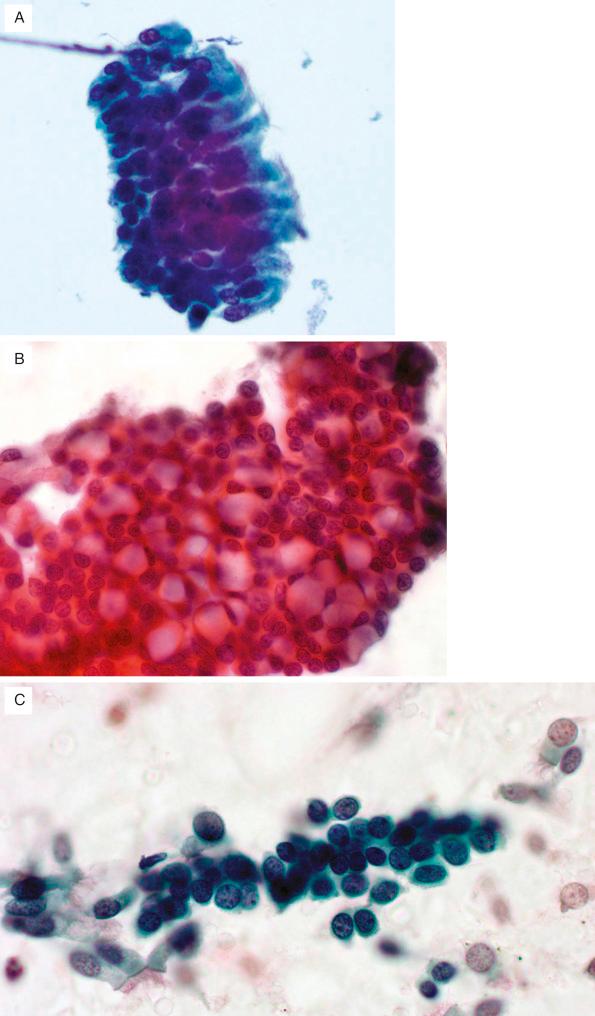
A variety of noncellular components are encountered with relative frequency in respiratory specimens. Some of these noncellular elements can serve as clues to an underlying disease process (Charcot-Leyden crystals, ferruginous bodies, Curschmann spirals) ( Fig. 36.5 ). Others are important to recognize as contaminants to avoid overdiagnosis of malignancy (pollen, vegetable cells) ( Fig. 36.6 ).
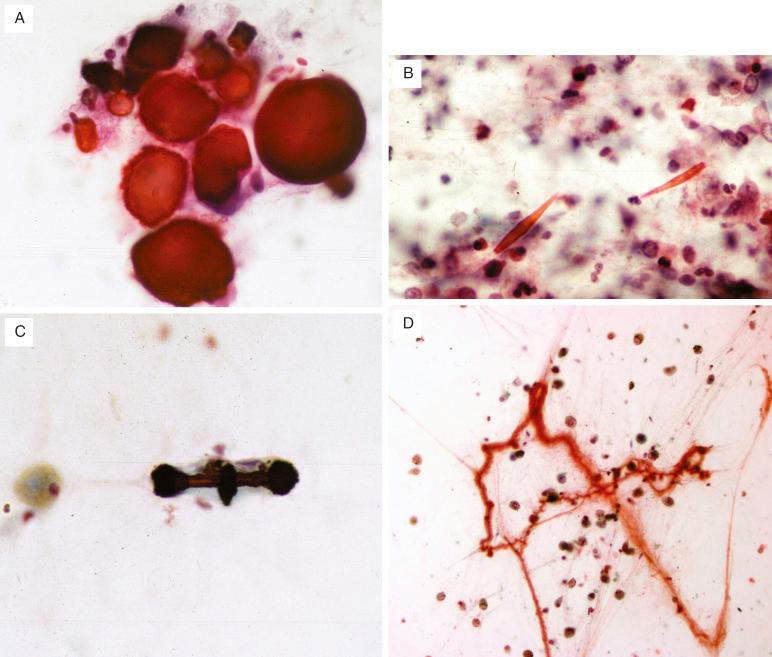

Loose clusters of epithelioid histiocytes (granulomas)
Multinucleated giant cells
Lymphocytes
Clean smear background
Negative cultures and special stains
Paucicellular sample of mononuclear inflammatory cells
Amorphous basophilic granular debris predominates
Negative fungal stain
The cytologic diagnosis of granulomatous inflammation in the lung and hilar or mediastinal lymph nodes is usually made by FNA. The diagnostic yield for combined transbronchial FNA of lung and lymph node reaches 80% to 90%, significantly higher than either of these procedures alone. The diagnosis of sarcoidosis requires both identification of nonnecrotizing granulomatous inflammation and exclusion of an infectious etiology in a patient with an appropriate clinical history and radiologic findings. Granulomas of sarcoidosis are recognized as loose clusters of epithelioid histiocytes with elongate nuclei and fibrillar cytoplasm associated with variable numbers of small lymphocytes in a clean background ( Fig. 36.7 ). Multinucleated giant cells are characteristically present, and the identification of isolated multinucleated giant cells should prompt a search for granulomas elsewhere in the sample. A separate sample submitted for microbiologic culture is essential to exclude infectious etiologies for the granulomatous inflammation. Special stains to rule out acid-fast bacilli and fungi may be performed on cell block material. A well-known diagnostic pitfall is overdiagnosis of granulomatous inflammation as adenocarcinoma.
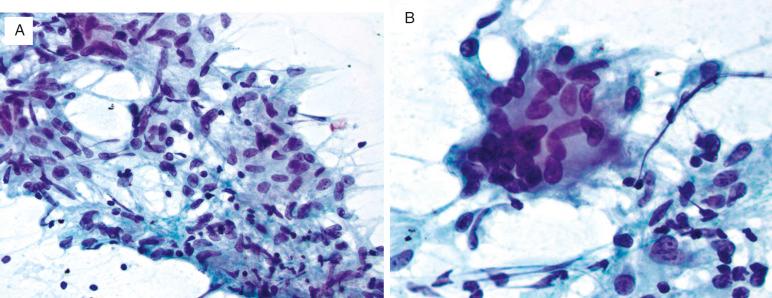
Nonnecrotizing granulomas may be seen in lymph node and lung samples from patients with malignancy, termed sarcoidlike reaction. Sarcoidlike reaction occurs in approximately 4% of patients with carcinoma and 13.8% of patients with Hodgkin lymphoma. Lymph nodes and lung nodules involved by a sarcoidlike reaction are generally positron emission tomography positive and difficult to distinguish from malignancy on imaging. Sarcoidlike reactions may precede the diagnosis of malignancy, occur concurrently, or occur later, mimicking recurrence/metastasis. Histologically, sarcoidlike reactions are indistinguishable from sarcoidosis when tumor is not present in the sample.
BAL is often the first diagnostic modality used in patients with pulmonary alveolar proteinosis. Grossly, BAL fluid from patients with pulmonary alveolar proteinosis is cloudy with granular debris. In stained preparations, this extracellular material usually predominates in the background of a paucicellular sample ( Fig. 36.8 ). Macrophages and scattered inflammatory cells are seen. The granular material represents surfactant and appears basophilic in Diff-Quik stain, cyanophilic in Papanicolaou (Pap) stain, and eosinophilic in hematoxylin-eosin stain. The material is strongly periodic acid–Schiff positive. The cytologic differential diagnosis includes Pneumocystis jirovecii infection, amyloidosis, and organizing pneumonia. A fungal stain should be performed on all cases of suspected pulmonary alveolar proteinosis to exclude Pneumocystis. Other organism stains (Fite, Gram) may also be appropriate to evaluate for coexisting infections with Nocardia and other bacteria. Amyloid is a “waxy,” smooth, and nongranular substance. It is usually only focally deposited and is rarely seen in BAL samples. Organizing pneumonia may show granular debris in the background, but inflammatory cells (including neutrophils) usually predominate. The diagnosis of pulmonary alveolar proteinosis requires correlation with clinical and radiographic findings.
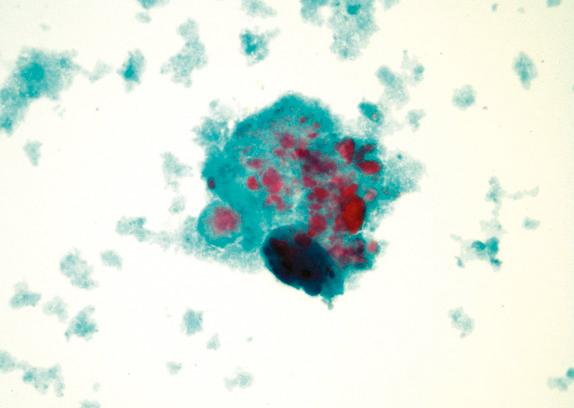
Ciliocytophthoria (detachment of cilia)
Reactive epithelial atypia
Specific viral inclusions
Cytologic changes associated with viral infections include specific diagnostic inclusions, regenerative epithelial atypia, and ciliocytophthoria ( Fig. 36.9 ). Ciliocytophthoria refers to detachment of the ciliated portion of the columnar bronchial epithelial cell with resultant free-floating tufts of cilia in the background of the smear. Although not entirely specific, ciliocytophthoria is commonly associated with adenovirus infection. If specific viral inclusions are identified, a rapid diagnosis is possible (see Chapter 13 ). Most viral infections are detected in BAL samples from immunocompromised hosts. Occasional cases are identified in FNA specimens.
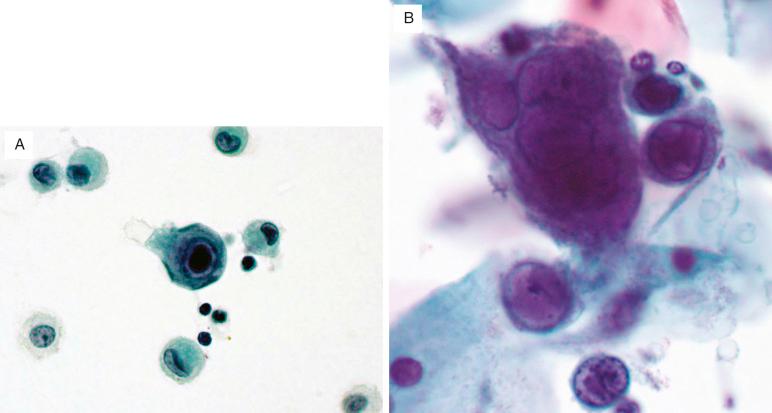
Cytomegalovirus-infected cells appear enlarged, with maintenance of the nuclear-to-cytoplasmic ratio. There is margination of nuclear chromatin with a large, central basophilic intranuclear inclusion surrounded by a pale halo. Granular, variably basophilic-to-eosinophilic cytoplasmic inclusions may also be seen. Cells infected with herpes simplex virus are enlarged and multinucleated. There is nuclear molding, margination of chromatin, and an intranuclear eosinophilic inclusion. Measles virus infection produces giant multinucleated cells with eosinophilic intranuclear and cytoplasmic inclusions. Similar giant cells may be seen in respiratory syncytial virus and parainfluenza infections.
Many fungal organisms are readily detectable in respiratory cytology samples. Some of these organisms are seen using conventional stains. Often, a specific morphologic diagnosis is possible. Diagnosis is generally more rapid than fungal culture.
Become a Clinical Tree membership for Full access and enjoy Unlimited articles
If you are a member. Log in here